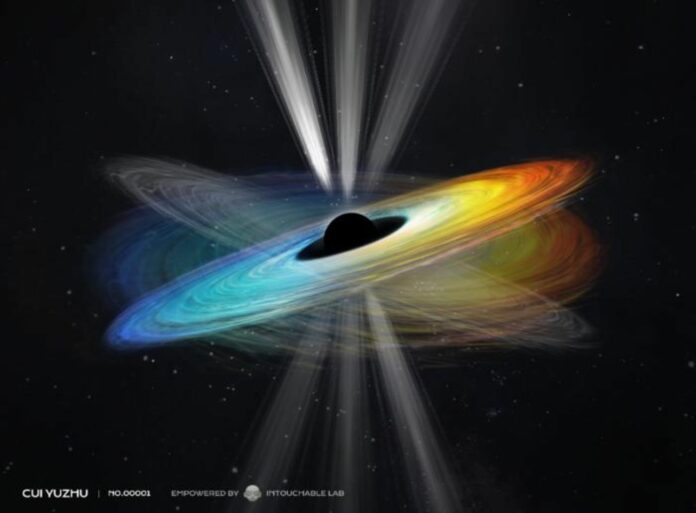The nearby radio galaxy M87 or Messier 87 is a giant elliptical galaxy at the dynamic center of the nearby Virgo cluster. It is one of the most robust radio sources in the sky. The galaxy harbors a supermassive black hole, M87*, which came to light in 2019 when it became the 1st black hole imaged by humanity.
The Event Horizon Telescope (EHT) captured the first image of the M87 supermassive black hole, known as M87*, and revealed it to the public in 2019. Now, a new study confirms the spinning of this black hole.
A jet oscillating up and down with an amplitude of roughly 10 degrees is present in the nearby radio galaxy M87, which is 55 million light-years from Earth and home to a black hole that is 6.5 billion times more massive than the Sun. This jet’s presence supports the black hole’s spin.
This study was conducted by an international team using a global network of radio telescopes.
The research team discovered an 11-year cycle in the precessional motion of the jet base, as predicted by Einstein’s General Theory of Relativity, through intensive examination of telescope data from 2000 to 2022. The study proves that M87’s black hole spins by linking the jet’s dynamics to that of the central supermassive black hole.
According to a widely accepted idea, energy can be extracted from a spinning black hole, allowing part of the supermassive black hole’s surrounding material to be ejected with immense power. Supermassive black hole spin, an essential component in this process and the most fundamental metric after black hole mass had not been directly detected.
Scientists in this study focused on M87. Recent black hole shadow imaging with the Event Horizon Telescope (EHT) shows that the jet generation regions adjacent to the black hole can be studied in detail with Very Long Baseline Interferometry (VLBI) due to its proximity. The scientists discovered the periodic precessional jet near M87’s base by examining the VLBI data collected over the previous 23 years, providing information about the state of the core black hole.
What force in the universe can change the path of such a powerful jet? is the crucial question at the center of this finding. The behavior of the accretion disk, which is connected to the center supermassive black hole, may hold the key to the solution. Due to their angular momenta, infalling materials orbit the black hole, forming a disk-like configuration before slowly spiraling inward until they are irrevocably pulled into the black hole. A process known as “frame-dragging,” which was foreseen by Einstein’s General Theory of Relativity, occurs when a black hole is spinning because it significantly impacts the spacetime around it.
According to the research team’s thorough investigation, a precessional jet results from a misalignment between the accretion disk’s rotational axis and the black hole’s spin axis. By confirming that the supermassive black hole in M87 is indeed rotating, the detection of this precession advances our knowledge of supermassive black holes.
CUI Yuzhu, a postdoctoral researcher at Zhejiang Lab, a research institution in Hangzhou, said, “We are thrilled by this significant finding. Since the misalignment between the black hole and the disk is relatively small and the precession period is around 11 years, accumulating high-resolution data tracing M87’s structure over two decades and thorough analysis are essential to obtain this achievement.”
Dr. Kazuhiro Hada from the National Astronomical Observatory of Japan said, “After the success of black hole imaging in this galaxy with the EHT, whether this black hole is spinning or not has been a central concern among scientists. Now, anticipation has turned into certainty. This monster black hole is indeed spinning.”
The East Asian VLBI Network (EAVN), the Very Long Baseline Array (VLBA), the joint array of KVN and VERA (KaVA), and the East Asia to Italy Nearly Global (EATING) network all contributed observations for a total of 170 epochs used in this study. This investigation was made possible by the contributions of more than 20 telescopes worldwide.
Chinese radio telescopes, such as the Tianma 65-meter radio telescope, with its enormous dish and great sensitivity at millimeter wavelengths, also contributed to this effort. The 26-meter radio telescope in Xinjiang also improves the angular resolution of EAVN measurements. Excellent sharpness and high-quality angular resolution data are required to attain this success.
Prof. SHEN Zhiqiang, Director of the Shanghai Astronomical Observatory of the Chinese Academy of Sciences, said, “The in-building Shigatse 40-meter radio telescope by Shanghai Astronomical Observatory will further improve the imaging capability of EAVN at millimeters. Especially the Tibetan Plateau, where the telescope is located, owns one of the most excellent site conditions for (sub-)millimeter wavelength observations. It fulfills our expectations to promote domestic sub-millimeter facilities for astronomical observations.”
Journal Reference:
- Cui, Y., Hada, K., Kawashima, T. et al. Processing jet nozzle connecting to a spinning black hole in M87. Nature 621, 711–715 (2023). DOI: 10.1038/s41586-023-06479-6
